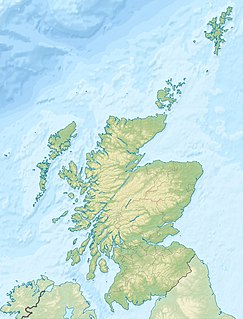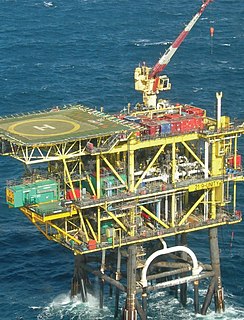Related Research Articles

Ormen Lange is a natural gas field on the Norwegian continental shelf. It is situated 120 kilometres (75 mi) northwest of Kristiansund, where seabed depths vary between 800 and 1,100 metres. The field is named after the famous longship Ormen Lange of Olaf Tryggvason, a 10th-century Viking king of Norway.

The Piper oilfield is a substantial North Sea oilfield covering 30.1 km2. It lies roughly halfway between Aberdeen and Bergen, at the eastern end of the Moray Firth basin. Oil extracted from it is piped to Scotland, where it is stabilised at an oil plant on the island of Flotta, in the Orkney Islands, while gas is shipped via the Frigg gas pipeline. In June 1975, the Piper Alpha oil platform was placed over the field in 144 m of water, secured in place by 24 piles extending 116 m beneath the seabed. The platform was designed for simultaneous drilling and production. Piper Alpha was the site of one of the world's worst oil platform disasters when it was destroyed by an explosion in 1988, with the loss of 167 lives. Piper Bravo was installed in 1992. Talisman Energy acquired a controlling interest in 2000.

The St Fergus Gas Terminal is a large gas terminal found near St Fergus, Aberdeenshire, Scotland. The other main UK gas terminals are at Bacton, Norfolk and the Easington, East Riding of Yorkshire.
The Fulmar Gas Line is a natural gas pipeline which transports natural gas from the central North Sea to St Fergus, Scotland. Originally, the pipeline carried natural gas from Fulmar and Clyde fields. Later also other fields in the Central North Sea, such as Kittiwake, Gannet, Nelson, Anasuria, Curlew, and Triton were connected to the pipeline.

The Langeled pipeline is an underwater gas pipeline transporting Norwegian natural gas to the United Kingdom. Before the completion of the Nord Stream pipeline, it was the longest subsea pipeline in the world.
Gassco is a Norwegian state owned company that operates 7,800 kilometres (4,800 mi) of natural gas pipes transporting annually of 100 billion cubic meter (bcm) of natural gas from the Norwegian continental shelf to Continental Europe and Great Britain.
Vesterled is a natural gas pipeline system, which runs from the Heimdal field in the North Sea to St Fergus Gas Plant near Peterhead in Scotland. The name Vesterled is the term used by the Vikings for their westward voyages, i.e. vesterled = "the way westward".
The Zeepipe is a natural gas transportation system to transport North Sea natural gas to the receiving terminal at Zeebrugge in Belgium.
Norpipe is the undersea oil and natural gas pipelines system in the North Sea. It supplies oil from the Norwegian Ekofisk and associated fields in the North Sea to the United Kingdom and natural gas to Germany.

The Forties pipeline system (FPS) is a major pipeline transport network in the North Sea. It is owned and operated by Ineos and carries 30% of the UK's oil, or about 550 thousand barrels per day of oil per day, to shore. It carries liquids production from 85 fields in the North Sea and several Norwegian fields on behalf of around 40 companies. The system has a capacity of 575,000 barrels of oil a day.
The Statpipe pipeline is a natural gas system, which links northern North Sea gas fields with the Norway's gas export system. It transports gas from Statfjord, Gullfaks, Heimdal, Veslefrikk, Snorre, Brage, Tordis and Statfjord gas fields.

The Central Area Transmission System is a natural gas transportation and processing system that transports natural gas through a 404 kilometre pipeline from the Central North Sea to a reception and processing terminal at Teesside in the North East of England.

Frigg gas field is a natural gas field on Norwegian block 25/1 in the North Sea, on the boundary between the United Kingdom and Norway. The field is named after the goddess Frigg. King Olav V of Norway officially opened production on 8 May 1978. Production was closed on 26 October 2004. The field is situated 230 kilometres (140 mi) northwest of Stavanger. Operator for the field was the French oil company Elf Aquitaine, which merged and changed name to Total S.A.
The United Kingdom's National Transmission System (NTS) is the network of gas pipelines that supply gas to about forty power stations and large industrial users from natural gas terminals situated on the coast, and to gas distribution companies that supply commercial and domestic users. It covers Great Britain, i.e. England, Wales and Scotland.

The Miller oilfield is a deep reservoir under the North Sea, 240 kilometres north-east of Peterhead in UKCS Blocks 16/7b and 16/8b. It was discovered in 1983 by BP in a water depth of 100 metres. Production from Miller field started in June 1992, and plateau production was from late 1992 to 1997 at rates of up to 150,000 barrels (24,000 m3) of oil and 255 million cu ft (7.2 million m3) of gas per day at standard conditions. Miller produced some 345 million barrels (54,900,000 m3) of oil during its lifetime. The field is named after Hugh Miller who contributed to Scottish geology in the early nineteenth century.
Gassled is a partnership to own the offshore natural gas transportation infrastructure at the Norwegian continental shelf. Its pipelines are operated by Gassco.
Oseberg Transport System (OTS) is a pipeline system in western Norway. It is 115 km (71 mi) long and runs from Oseberg, Veslefrikk, Brage, Frøy and Lille-Frigg to Sture terminal, located 65 kilometres (40 mi) north of Bergen, Norway. The operation of the pipeline was commenced in 1988. Total investment in the pipeline construction was about 9.8 billion NOK.

Gjøa oilfield is an oilfield in the Norwegian section of the North Sea. It lies about 70 kilometres (43 mi) off the Troll field.

The Shetland Gas Plant is a natural-gas processing plant in the Shetland Islands, Scotland.
The Tartan oil field is a significant crude oil producing field in the UK sector of the North Sea, 187 km north-east of Aberdeen. Production of oil started in 1981 and ceased in 2020, the Tartan Alpha installation is currently (2021) undergoing decommissioning.
References
- ↑ "St Fergus Gas Terminal" (PDF). Total S.A. Archived from the original (PDF) on 17 July 2011. Retrieved 19 December 2009.
- ↑ "The Frigg Transportation System" (PDF). University of Aberdeen . Retrieved 19 December 2009.Cite journal requires
|journal=(help) - 1 2 "Technical description". Total S.A. Archived from the original on 24 October 2009. Retrieved 19 December 2009.